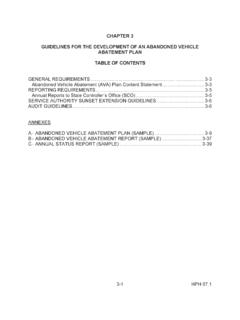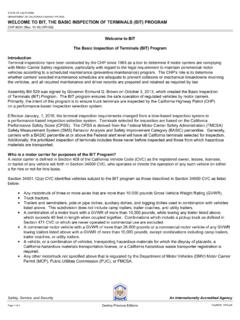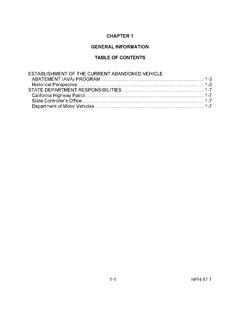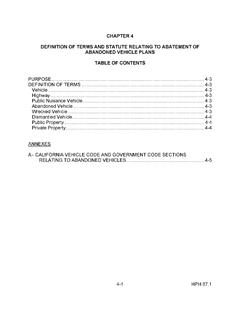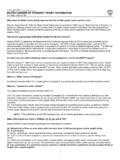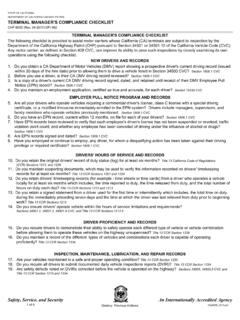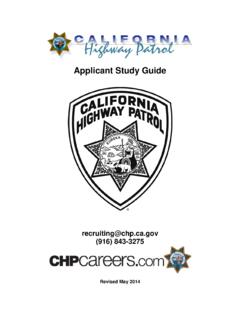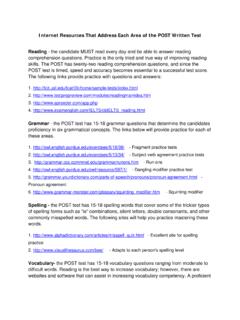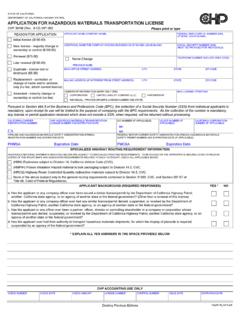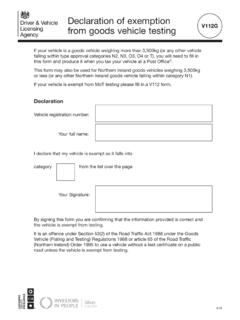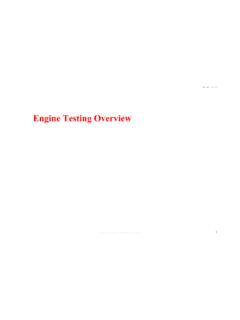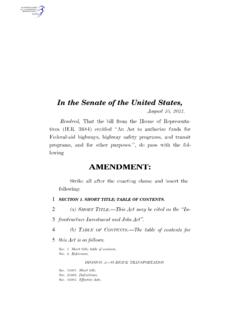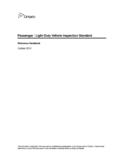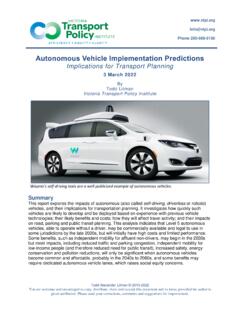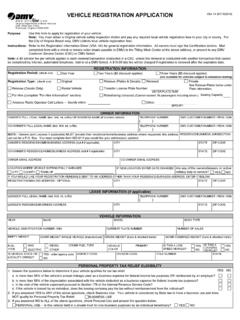Transcription of What is CSAT? Controlled Substances and Alcohol Testing ...
1 STATE OF CALIFORNIA DEPARTMENT OF CALIFORNIA HIGHWAY PATROL WHAT IS CSAT? Controlled Substances AND Alcohol Testing CHP 800J (New 9-16) OPI 062 Safety, Service, and SecurityAn Internationally Accredited Agency 1 of 5 WHAT IS CSAT? Controlled Substances AND Alcohol TESTINGLEGISLATIVE AUTHORITY Section 34520 of the California vehicle Code (CVC) requires motor carriers and drivers to comply with the Controlled Substances and Alcohol Testing (CSAT) requirements of the Federal Motor Carrier Safety Administration (FMCSA) or the Federal Transit Administration. These regulations are found in Title 49 of the Code of Federal Regulations (CFR), Parts 40, 382, , , and 655. The complete text of the regulations may be viewed using the Internet at: and The regulations require an employer-based CSAT program. Employers are responsible to conduct a program intended to identify drivers of commercial motor vehicles (CMV) who are using Controlled Substances , or Alcohol while on duty, and immediately preclude them from operating a CMV.
2 This requirement includes an individual who is self-employed, commonly known as an owner-operator. The regulations require a urine sample Testing for Controlled Substances , and breath Testing for Alcohol . The regulations prescribe when Testing is required: Pre-employment Testing Post-accident Testing Random Testing Reasonable suspicion Testing Return-to-duty Testing Follow-up Testing The California Highway Patrol (CHP) is authorized by statute to conduct inspections of a carrier's CSAT program, and issue a safety compliance rating indicating the carrier's CSAT compliance. Since the CVC incorporates the federal regulations, the CHP uses the federal definitions and interpretations when determining a carrier's CSAT compliance. Inspections are to be conducted at the carrier's principal place of business. WHO IS REGULATED? The CSAT regulations apply to the employers and drivers who operate CMVs which require a commercial driver license.
3 The definition of a CMV is included below. Commercial Motor vehicle means a motor vehicle or combination of motor vehicles used to transport passengers or property if the vehicle : Is of any size and is used in the transportation of hazardous materials that is required to be placarded under Title 49 CFR, Part 172. Is designed to transport 16 or more passengers, including the driver. STATE OF CALIFORNIA DEPARTMENT OF CALIFORNIA HIGHWAY PATROL WHAT IS CSAT? Controlled Substances AND Alcohol Testing CHP 800J (New 9-16) OPI 062 Safety, Service, and SecurityAn Internationally Accredited Agency 2 of 5 Has a gross combination weight rating or gross combination weight of 11,794 kilograms or more (26,001 pounds or more), whichever is greater, inclusive of a towed unit(s) with a gross vehicle weight rating (GVWR) or gross vehicle weight (GVW) of more than 4,536 kilograms (10,000 pounds), whichever is greater.
4 Has a GVWR or GVW of 11,794 or more kilograms (26,001 pounds or more), whichever is greater. There are some specific exceptions to the CSAT requirements. Transit bus carriers which are required to conduct a CSAT program under Title 49 CFR, Part 655 are not subject to the requirements of Part 382. In addition, drivers of certain vehicles who are not required to have a commercial driver license, are not subject to the CSAT requirements. In California, a vehicle with a passenger capacity between 11 and 15 passengers, including the driver, is defined as a bus. Employers and drivers of buses with a passenger capacity of less than 16, including the driver, are not subject to the CSAT requirements. THE PROHIBITIONS For the purpose of CSAT compliance, the term Controlled Substances includes: Marijuana metabolites Cocaine metabolites Amphetamines Opiate metabolites Phencyclidine (commonly referred to as PCP) The use of these Substances by CMV drivers is prohibited.
5 These five Substances are the only Substances for which Testing may be conducted per Title 49 CFR. When a driver has a positive test result, the employer must not permit the driver to operate a CMV until the driver has successfully completed the return-to-duty process. If a driver refuses to submit to a required test, the refusal is treated in the same manner as a positive test result. Additionally, in the event that a driver has violated the prohibitions, employers must not permit the driver to operate a CMV until the driver has successfully completed the return-to-duty process. This process includes an evaluation, referral, education, and treatment by a Substance Abuse Professional and a verified negative return-to-duty test before the driver can once again operate a CMV. Finally, the employer must ensure the driver submits to at least six unannounced follow-up tests for the first 12 months.
6 Use of Alcohol is generally legal, but not while driving a CMV, or within 4 hours prior to operating a CMV. When a driver has an Alcohol test result with a blood Alcohol content of .02 or greater, but less than .04, the employer must not permit the driver to operate a CMV until at least 24 hours have passed following the test. When a driver has an Alcohol test result with a blood Alcohol content of .04 or more, the employer must not permit the driver to operate a CMV until the driver has successfully completed the return-to-duty process identified in regulation. STATE OF CALIFORNIA DEPARTMENT OF CALIFORNIA HIGHWAY PATROL WHAT IS CSAT? Controlled Substances AND Alcohol Testing CHP 800J (New 9-16) OPI 062 Safety, Service, and SecurityAn Internationally Accredited Agency 3 of 5 PRE-EMPLOYMENT Testing An employer may not allow a driver to operate a CMV until after the employer has received a verified negative test result from a pre-employment Controlled Substances test, unless the employer meets an exception in Title 49 CFR, Part 382.
7 PREVIOUS EMPLOYER INQUIRY When an employer hires a new driver, the new employer must make a reasonable, good faith effort to obtain information of all the driver's previous employers within the prior two years. The purpose of the contact is to inquire if the previous employer is aware of any violations of the CSAT prohibitions committed by the driver. The driver must sign a written authorization to release the information from the previous employer to the new employer. If the driver does not sign the authorization, the new employer may not use the driver. The new employer must have the information from this inquiry on file within 30 days of hiring the driver, or the new employer may not continue to use the driver. RANDOM Testing Every employer must have a random CSAT program and ensure all CMV drivers are immediately enrolled. Drivers must be selected at random and sent immediately for Testing .
8 The current random selection rates are 25% of driver positions each year for Controlled Substances , and 10% of driver positions each year for Alcohol . The random selection rates are subject to change. Random selections must be reasonably spread out throughout the year, and the selections must be made by a scientifically valid random method, such as a random number table or a computer-based random number generator. POST-ACCIDENT Testing Drivers must be tested for Controlled Substances and Alcohol as soon as practicable after certain traffic collisions involving a CMV operating on public roads. Drivers are prohibited from using Alcohol after such collisions for either eight hours, or until a post-accident Alcohol test is conducted, whichever occurs first. The following table indicates when a post-accident test is required:Type of collisionWas the CMV driver cited?Employer must test?
9 Fatal (Someone died from the collision)Yes NoYes YesInjury (Someone required medical help away from the scene)Yes NoYes NoDisabling Damage (One or more vehicles required towing)Yes NoYes NoREASONABLE SUSPICION Testing A driver must submit to a CSAT test any time the employer has a reasonable suspicion to believe the driver has violated the CSAT prohibitions. Only a supervisor who has been properly STATE OF CALIFORNIA DEPARTMENT OF CALIFORNIA HIGHWAY PATROL WHAT IS CSAT? Controlled Substances AND Alcohol Testing CHP 800J (New 9-16) OPI 062 Safety, Service, and SecurityAn Internationally Accredited Agency 4 of 5trained may make the determination to test. Each supervisor is required to receive a minimum of one hour of training on Alcohol abuse, and one hour of training on Controlled Substances abuse. CSAT POLICY/DRIVER EDUCATION MATERIALS Employers must educate their drivers as to what is expected of them when it comes to CSAT.
10 Drivers must know the CSAT regulations, as well as the employer's specific procedures for occasions where the regulations are silent. Employers must retain the original certificate of receipt, signed by each driver, certifying that the driver has received a copy of such materials. RECORD KEEPING Employers are required to retain all records pertaining to their CSAT program. When requested by the CHP, CSAT records must be made available for inspection within two business days. All CSAT records which identify a driver must be kept confidential. It is important to have a place where these records can be locked-up, and access to these records strictly Controlled . CSAT SERVICE PROVIDERS The regulations allow for third parties to act on the employer's behalf under certain circumstances. There are many companies who provide CSAT services, and are in the business of helping employers comply with the regulations.
